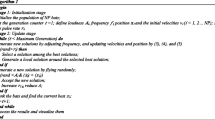Abstract
This paper proposes a hybrid bat algorithm with natural-inspired algorithms for continuous optimization problem. In this study, the proposed algorithm combines the reproduction step from weed algorithm and genetic algorithm. The reproduction step is applied to clone each bat population by fitness values and the genetic algorithm is applied in order to expand the population. The algorithm is evaluated on eighteen benchmark problems. The computational results of the proposed algorithm are compared with the methods in the literature which are self-adaptive differential evolution (DE), traditional DE algorithm, intersection mutation differential evolution (IMDE) algorithm, and the JDE self-adaptive algorithm. Findings show that the algorithm produces several solutions obtained by the previously published methods especially for the continuous unimodal function, the quartic function, the multimodal function and the discontinuous step function. In addition, the finding shows that the proposed algorithm can produce optimal solutions efficiently on benchmark instances within short computational time.


Similar content being viewed by others
References
Yang XS (2010) A new metaheuristic bat-inspired algorithm. In: Cruz C, Gonzales JR, Pelta DA, Terrazas G (eds) Nature inspired cooperative strategies for optimization (NISCO 2010) studies in computational intelligence, vol 284. Springer, Berlin, pp 65–74
Fister I Jr, Fister D, Yang XS (2013) A hybrid bat algorithm. Elektrotehniski vestnik 80(1–2):1–7
Yang XS, Gandomi AH (2012) Bat algorithm: a novel approach for global engineering optimization. Eng Comput 29(5):464–483
Tsai PW, Pan JS, Liao BY, Tsai MJ, Istanda V (2011) Bat algorithm inspired algorithm for solving numerical optimization problems. Appl Mech Mater 148–149:134–137
Ramesh B, Mohan VCJ, Reddy VCV (2013) Application of bat algorithm for combined economic load and emission dispatch. Int J Electr Eng Telecommun 2(1):1–9
Musikapun P, Pongcharoen P (2012) Solving multi-stage multi-machine multiproduct scheduling problem using bat algorithm. In: 2nd international conference on management and artificial intelligence (IPEDR), vol 35. IACSIT Press, Singapore, pp 98–102
Mishra S, Shaw K, Mishra D (2012) A new meta-heuristic bat inspired classification approach for microarray data. Procedia Technol 4:802–806
Yılmaza Selim, Küçüksille EU (2015) A new modification approach on bat algorithm for solving optimization problems. Appl Soft Comput 28:259–275
Mehrabian AR, Lucas C (2006) A novel numerical optimization algorithm inspired from invasive weed colonization. Ecol Inf 1:355–366
Basak Aniruddha, Maity Dipankar, Das Swagatam (2015) A differential invasive weed optimization algorithm for improved global numerical optimization. Appl Math Comput 219(2013):6645–6668
Zhang X, Niu Y, Cui G, Wang Y (2010) A modified invasive weed optimization with crossover. In: Proceedings of the 8th world congress on intelligent control and automation, pp 11–14
Fister I Jr, Fister D, Yang XS (2013) A hybrid bat algorithm, CoRR abs/1303.6310
Parpinelli RS, Lopes HS (2011) New inspirations in swarm intelligence: a survey. Int J Bio Inspir Comput 3:1–16 (View at Google Scholar)
Yao X, Liu Y, Lin G (1999) Evolutionary programming made faster. IEEE Trans Evol Comput 3(2):82–102
Jitkongchuen Duangjai, Thammano Arit (2014) A self-adaptive differential evolution algorithm for continuous optimization problems. Artif Life Robot 19:201–208
Brest J, Greiner S, Boskovic B, Mernik M, Zumer V (2006) Self-adapting control parameters in differential evolution: a comparative study on numerical benchmark problems. IEEE Trans Evol Comput 10(6):646–657
Zhou Y, Li X, Gao L (2013) A differential evolution algorithm with intersect mutation operator. Appl Soft Comput 13:390–401
Acknowledgments
The authors would like to acknowledge School of Information and Communication Technology, University of Phayao for all resources and highly grateful to Associate Professor Dr. Arit Thammano and Dr. Ravee Phoewhawm for the technical assistance.
Author information
Authors and Affiliations
Corresponding author
About this article
Cite this article
Pravesjit, S. A hybrid bat algorithm with natural-inspired algorithms for continuous optimization problem. Artif Life Robotics 21, 112–119 (2016). https://doi.org/10.1007/s10015-015-0248-3
Received:
Accepted:
Published:
Issue Date:
DOI: https://doi.org/10.1007/s10015-015-0248-3




